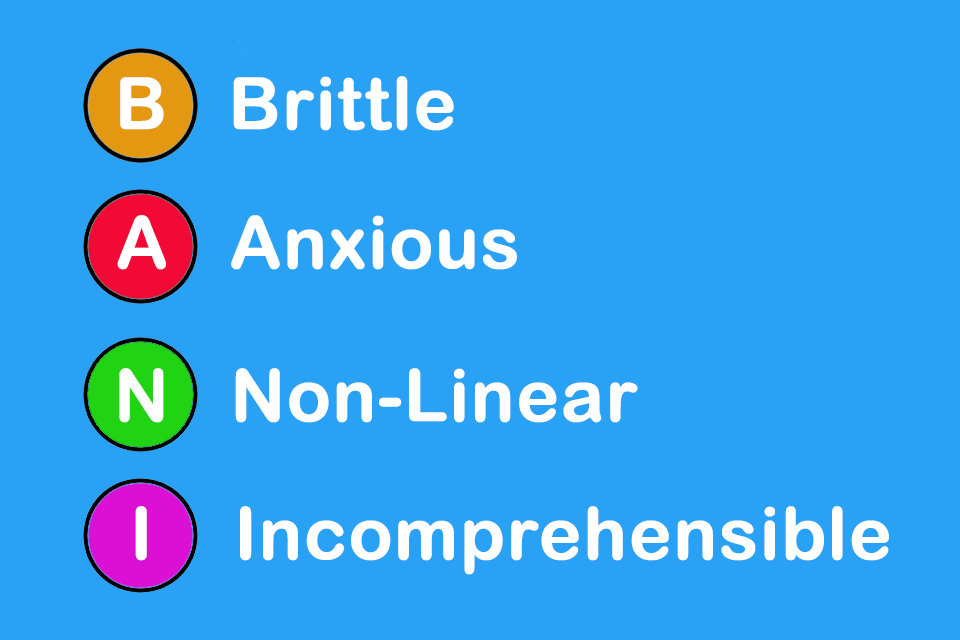What is BANI?
Smartpedia: BANI stands for Brittle, Anxious, Non-linear and Incomprehensible. It is considered a sensemaking model that provides orientation in chaotic times.
BANI – making change tangible
Many companies are experiencing markets whose conditions are no longer just unstable, but almost chaotic. They notice how individual actions have global effects. They worry that all the decisions they make could be wrong. They are no longer able to track cause and effect because they have no known relationship. Such companies experience: BANI.
BANI is an acronym and stands for:
- Brittle
- Anxious
- Non-Linear
- Incomprehensible
BANI is a so-called Sensemaking Model¹ – sometimes also referred to as a BANI Framework². It tries to make the change that many things are undergoing tangible and to put it into words.
BANI in detail
What do the individual letters in BANI stand for?
B for Brittle states that structures and systems that are rigid and not very adaptable become brittle and porous. In physics, rigid objects break quickly under great pressure. Systems in the business world are often geared towards maximising profits and go to their breaking point to do so. Also due to past successes, such systems appear strong on the outside, but are often weak and brittle on the inside. This can be observed, for example, in high employee turnover, in the difficult scaling of business models or in numerous transformation projects that cause a lot of effort but have little effect.
A for Anxious describes a situation in which organisations – and the people who work in and for the organisation – struggle to make decisions. In biology, fear is a useful advisor because it ensures avoidance of dangerous, often life-threatening situations. In the business world, fear often leads to postponing decisions. “Better not to make a hasty decision than a wrong one” seems to be a credo that can be observed in companies. This can be seen, for example, in business models that are not very future-proof or in projects that are not cancelled even though there are clear indicators that they should be..
N for Non-linear means that the connection between cause and effect, action and reaction – also known as the interaction principle or Newton’s third law – is lost. Applied to the business world, this means that any action, any change, any public statement could have unpredictable consequences. Everything is connected to everything else, little can be causally related, uncertainty reigns. Companies react to this with avoidance strategies, with additional planning meetings and purely factual decisions.
I for Incomprehensible describes a situation in which events, measures and decisions appear incomprehensible and incomprehensible. Numerous companies operate in such situations and are dependent on rules issued at short notice by legislators. New market rules lead to new mechanisms and new challenges. Planning certainty is lost. In a way, a chaotic system is created.
BANI and VUCA
There are different opinions on the relationship between BANI and VUCA. The acronym VUCA (volatility, uncertainty, complexity, ambiguity) describes a rapidly changing business world with numerous challenges for companies. According to Jamais Cascio, who founded the logic of BANI³, then BANI is a logical continuation³, an adaptation of VUCA into the present:
“The concept of VUCA is clear, evocative, and increasingly obsolete. We have become so thoroughly surrounded by a world of VUCA that it seems less a way to distinguish important differences than simply a depiction of our default condition. Using “VUCA” to describe reality provides diminishing insight; declaring a situation or a system to be volatile or ambiguous tells us nothing new…
With a new paradigm we need a new language. If we set VUCA aside as insufficient, we still need a framework that makes sense of not just the present world but its ongoing consequences as well. Such a framing would allow us to illustrate the scale of the disruptions, the chaos, underway, and enable consideration of what kinds of responses would be useful”.
Many supporters of BANI share this view. However, there are also opposing opinions that speak of a coexistence of the approaches. Consequently, it is not important to decide in favour of one model, but to use and act with the models accordingly. If one prescribes VUCA in a complex environment, an explorative approach makes sense. VUCA can be countered with vision, an understanding of the concrete situation, clarity and agility. BANI, on the other hand, relies in chaos on transparency and intuition, on resilience and flexibility, on mindfulness and empathy. Ideally, this also increases the resilience of the system.
Of course, there are also experts who perceive VUCA and BANI as something very similar. Non-linearity and ambiguity, incomprehensibility and complexity sound at least related. Accordingly, people and organisations operate in a volatile, non-linear, sometimes chaotic, complex world in which much is uncertain. Accordingly, systems need to be rethought and decisions made despite all doubts. Welcome to the VUCA-BANI world.
Impulse to discuss
BANI addresses the chaotic situation in which “the world” finds itself. But is the world chaotic for companies, for example, or is it simply so closely interconnected that small causes have large, sometimes unpredictable effects?
[1] Sensemaking is a concept associated with Karl Weick and his work on organisational behaviour. It refers to a series of processes that attempt to improve one’s understanding of a situation: Sensemking in Organizations (Foundations for Organizational Science)
[2] Framework as a term has different meanings. In the sense of a reference system or explanatory structure, BANI could be interpreted as a framework.
[3] Jamais Cascio: Facing the Age of Chaos
Here you can find a German video about BANI: Volatile was yesterday, brittle is today
If you like the article or would like to discuss it, please feel free to share it in your network. And if you have any comments, please do not hesitate to send us a message.
Here you will find additional information from the t2informatik Blog:



